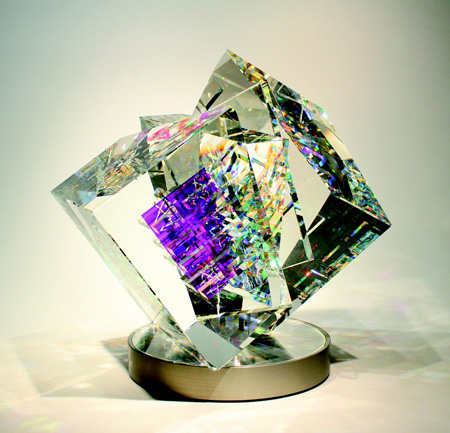
Continuing through January 6, 2013
Mesa Contemporary Arts is one among a number of institutions around the country commemorating the time in 1962 when workshops by pioneer glass artist Harvey Littleton helped pave the way for glass-making to become less utilitarian and more aesthetic. Glass pieces began to be created outside the factories in studio settings, where individual artists were free to move beyond traditional form and function. The Center's complex makes a fitting location for a show of contemporary glass, as it also hosts a glass studio and assorted workshops which have nurtured glass artists in Arizona for the last decade.
“Fire and Sand” takes its title for the two elements that forge glass, and provides ample evidence that glass art can “shatter” expectations. Among the approximately three dozen works, there is a wealth of ingenuity and skill. Objects both delicate and imposing emerge from glassblowing, glass casting, flame-working, fusing, lamp-working and woven glass. In addition, artists Matt Eskuche, Joe Feddersen, Carole Perry, Therman Statom, S.A. Hawkins and Stephanie Trenchard explore abstraction and surrealism, test the boundaries of sculpture and give their work narrative qualities. Among these affecting narrative pieces is Karen LaMonte’s “Child’s Dress,” made of cast glass. Life-size and translucent to the point of being ghostly, it imparts loss and sadness.
This is a national cross-section of artists. Glass art has the potential to mesmerize, as is the case with works by Toland Sand of New Hampshire, who plays with the unusual optical qualities of polished crystal and dichroic (multicolored) glass in “Fractalized Rosetta.” Every angle around the 9-inch-high, divided cube yields a different version of the tiny hieroglyphics inside the cube. David Schwarz of Ridgefield, Washington, is represented by two works, both blown-glass balls overlaid with facets and intricate color etchings. The orbs beg to be peered into for the optical illusions they create. An organic approach to glass comes from Tom Philabaum of Tucson, Ariz., whose “Pollen Wave” fills a back wall of the gallery. Inspired by microscopic views of pollen grains, the balloon-like pieces undulate across the wall, with color changes that mimic nature.
In addition to “Fire and Sand,” the Project Room features the edgier glass work of Tim Tate and Marc Petrovic, who are part of a newer “Glass Secessionism” movement. Incorporating new technology, as well as a variety of media and found objects into glass sculptures is part of these artists’ practice, as can be seen in their collaborative work “The Seven Deadly Sins.” Each sin gets its due through objects placed under glass. “Lust,” for instance, is the apple tree from the Garden of Eden, accompanied by a cellphone-like video showing a belly dancer. Tate and Petrovic bring a welcome spirit of experimentation, pathos and humor to their work.
